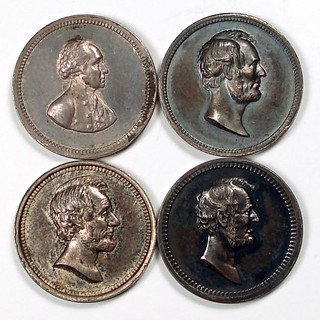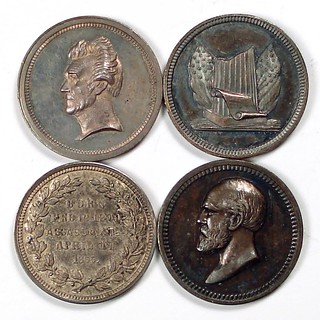
PREV ARTICLE
NEXT ARTICLE
FULL ISSUE
QUERY: METAL COMPOSITION OF US MINT MEDALSJonathan Brecher submitted this question about the metal composition of 19th century U.S. Mint medals. Thanks. -Editor
Has anyone done studies on the metal composition of 19th century US Mint medals? Conventional wisdom says that US Mint medals from the 19th century are almost all struck in pure gold or silver. Julian writes (p. XXXIII): "All gold medals struck at the mint, with a few minor exceptions, were of pure gold. Alloyed gold was harder on the dies than pure metal. On rare occasion, and listed as such in the text, medals were struck of coin gold, or 900/1000 fine. … As with gold, only pure silver was ordinarily used for medals. Standard (900/1000 fine) silver was used occasionally; in one instance half dollar planchets were used to strike silver medals for the Mecklenburg Centennial." The local coin dealer recently bought an electronic "precious metal verifier". It's not as detailed as a full-blown XRF analysis, but the equipment is much less expensive. You can also use it without removing medals from their holders (even stapled 2X2s are ok), and it reads past the plating to whatever is inside. It's also FAST — 2-3 seconds per piece if you're going slowly. His model has modes for several purities, including .9999, .999, .925, .900, and .800 (Canadian) silver. It doesn't tell you what the purity is, but it does tell you relative to the selected mode. So for example, a Sterling piece would read "low" in .999 mode, "high" in .900 mode, and right on target in .925 mode. That means that there was really one more mode that could turn up, "still silver but less than .800 fine". He let me use it for an hour or so on a slow afternoon (thanks, Eric!), and I was able to check out a whole bunch of US Mint medals. As expected, almost all of them tested as pure silver… except for the ones that didn't. Much to my surprise, a group of the smaller medals tested as .800 or lower. Those low-silver pieces included PR-36, PR-40, PR-41, PR-42, and PR-43, as well as CM-2 and CM-43. On the other hand, the similar small-sized PR-26, PR-27, PR-28, PR-29, PR-30, PR-31, PR-32, PR-33, PR-38, and PR-39, and PR-44 all tested .999 as expected. I always considered those small-sized medals to be a single series, all produced the same way. I'm at a loss to explain these results. Can anyone shine some light on what's going on?   Left: Obverses; Right: Reverses PR-28 and PR-38 (top row) tested as pure silver (.999 fine). Interesting. Can anyone help? -Editor
THE BOOK BAZARREWayne Homren, Editor The Numismatic Bibliomania Society is a non-profit organization promoting numismatic literature. See our web site at coinbooks.org. To submit items for publication in The E-Sylum, write to the Editor at this address: whomren@gmail.com To subscribe go to: https://my.binhost.com/lists/listinfo/esylum All Rights Reserved. NBS Home Page Contact the NBS webmaster 
|